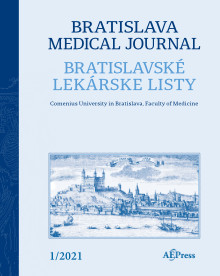Journal info
|
||||
Select Journal
Journals
Bratislava Medical Journal 2024 2023 2022 2021 2020 2019 2018 2017 2016 2015 2014 2013 2012 Ekologia - Ecology Endocrine Regulations General Physiology and Biophysics Neoplasma Acta Virologica Studia Psychologica Cardiology Letters Psychológia a patopsych. dieťaťa Kovove Materialy-Metallic Materials Slovenská hudba 2025Webshop Cart
Your Cart is currently empty.
Info: Your browser does not accept cookies. To put products into your cart and purchase them you need to enable cookies.
Bratislava Medical Journal Vol.120, No.7, p.494–497, 2019 |
||
| Title: 3D navigation in surgery of Eagle syndrome | ||
| Author: L. Czako, D. Hirjak, K. Simko, A. Thurzo, A. Janovszky, B. Galis | ||
| Abstract: NTRODUCTION: Eagle’s syndrome is a rare condition caused by the elongation of the styloid process (> 4 cm) or calcification of the stylohyoid ligament. Patients with Eagle’s syndrome typically present various clinical symptoms, such as headache, facial pain, neck pain, pulsating pain, sore throat, foreign body sensation, dysphagia, dysphonia, cough, voice changes, otalgia or vertigo. 3D printing refers to processes in which successive layers of material are formed from 3D computer tomography data to synthesize a three-dimensional object. This new diagnostic technique of rapid prototyping technology led to innovative new applications in biomedicine. OBJECTIVE: The primary goal for this case study was to find out, whether the nowadays so popular 3D technology aids in the treatment of the Eagle syndrome or other similar craniofacial abnormalities during the surgical procedure. CASE PRESENTATION: We report a case of a patient who initially presented a combination of symptoms like headache, sore throat, neck pain, which exacerbated with the movement of the head. This case report provides a brief review of the diagnosis and surgical management of the Eagle’s syndrome with the help of 3D model navigation. CONCLUSION: Eagle’s syndrome is difficult to diagnose due to its wide variability in symptoms. The inherent accuracy and other properties of 3D printing have allowed it to have exciting applications in anatomy education and surgery, with great benefit to the maxillofacial surgery. With the assistance of 3D technology, it is much easier for the surgeon to plan the surgical approach and the surgery, and significantly reduce the operation time (Fig. 3, Ref. 22). |
||
| Keywords: Eagle syndrome, stylohyoidectomy, 3D assisted surgery, printed models, three dimensional navigation. | ||
| Published online: 12-Jul-2019 | ||
| Year: 2019, Volume: 120, Issue: 7 | Page From: 494, Page To: 497 | |
| doi:10.4149/BLL_2019_078 |
||
|
|
 download file download file |
|

